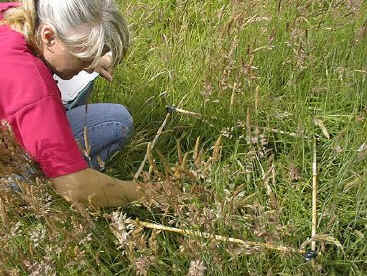The Woodland Education Centre
Heathland Project Report
Introduction List of Summary Points Summary
DETAILED METHODS
 In July 1996, the flora of the heathland site was
surveyed by stretching a transect line (a rope marked at 1m intervals) across the centre
of the site, from the southern boundary of section 1 across to the northern boundary of
section 9 (diagram). A 0.5 m2 quadrat (a square frame measuring
0.5m on each side) was placed on the ground every 2m along the line. The plant species
inside the quadrat were identified, their % cover was estimated and their maximum height
noted. This type of survey is called a belt transect, because it measures species
abundance across a narrow band (similar to a belt). In addition to the belt transect, a
general survey was also carried out to make note of other plant species occurring outside
the transect area.
In July 1996, the flora of the heathland site was
surveyed by stretching a transect line (a rope marked at 1m intervals) across the centre
of the site, from the southern boundary of section 1 across to the northern boundary of
section 9 (diagram). A 0.5 m2 quadrat (a square frame measuring
0.5m on each side) was placed on the ground every 2m along the line. The plant species
inside the quadrat were identified, their % cover was estimated and their maximum height
noted. This type of survey is called a belt transect, because it measures species
abundance across a narrow band (similar to a belt). In addition to the belt transect, a
general survey was also carried out to make note of other plant species occurring outside
the transect area.
Progress of the Heathland Restoration Project has been monitored on an annual basis since this initial survey was carried out. The survey in 1996 was based solely on the belt transect method. Subsequent surveys have incorporated random sampling, as well as a belt transect. Random quadrats were included because it was felt that the belt transect only covered a very narrow band across the centre of the site. While this allowed comparisons to be made between the vegetation of different sections, it did not necessarily accurately reflect the overall plant cover of the sections.
Random quadrats were sampled in each of sections 1 - 9, at the same time as the belt transect was carried out. The position of random quadrats was determined using a random number table to select the number of paces to be walked, on a co-ordinate basis. As there also appeared to be a visual difference between the vegetation in the top and bottom halves of some of the sections, these were sampled separately to see if there were any measurable differences. The transect line acted as the median point.
For the belt transect method, quadrats were surveyed every other metre along the line, in each section. An equivalent number of random quadrats were sampled in the top of each section. This was repeated for the bottom section of each strip. As a result, twice the number of random samples were taken in each strip overall compared to the belt transect.
The two sets of results together cover all areas of the heathland site and give a good picture of alterations in the vegetation cover of the site with time.
Continue to comparison sampling methods| Heathland Restoration Project Report | ||||
Other Lowland Heaths in East Devon
